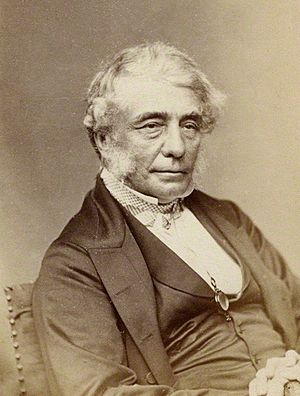John Peter Gassiot facts for kids
John Peter Gassiot (born April 2, 1797 – died August 15, 1877) was an English businessman and a scientist who loved to learn. He was well-known for showing off amazing electrical experiments to the public. He also helped make the Royal Society a better place for science.
Contents
Early Life and Business
John Peter Gassiot was born in London. When he was young, he joined the Royal Navy as a midshipman, which is a junior officer. In 1819, he married Elizabeth Scott, and they had many children together.
In 1822, he started a business called Martinez Gassiot & Co. with Sebastian Gonzalez Martinez. Their company sold things like cigars, sherry wine, and port.
Even though he was a busy businessman, John Peter Gassiot was also very interested in science, especially electricity. He set up a fantastic laboratory at his home in Clapham Common. He even let other scientists, like James Clerk Maxwell, use his lab for their own important experiments.
Helping Science Grow
Gassiot worked closely with other scientists like William Sturgeon and Charles Vincent Walker. Together, they helped start the London Electrical Society in 1837. This society became famous because Gassiot put on exciting public shows about electricity.
In 1841, he became a Fellow of the Royal Society, which is a big honor for scientists. He played a key role in making important changes to the Royal Society in the 1840s. He also helped create the Chemical Society in 1845. He was also involved with the London Institution and worked as a magistrate in Surrey.
His Scientific Discoveries
John Peter Gassiot worked with William Robert Grove at the Royal Society. Gassiot encouraged Grove to join the London Institution, where they both worked on developing photography.
Gassiot's experiments were very important. He helped show that a popular idea about how electricity worked, called the "contact theory," was wrong. Starting in 1840, he did many tests. In 1844, he used a large battery made of 100 special Grove cells. These cells were kept separate from each other. He showed that you could get an electrical spark even before two electrical parts touched.
He also continued Grove's work on striae, which are patterns seen in electrical discharges. Gassiot proved that these electrical discharges cannot continue in a vacuum, which is a space with no air.
In 1858, Gassiot gave a special lecture called the Bakerian lecture. He reported that electrical discharges in very thin gases could be moved by both magnetism and electrostatics. This was an early observation of what we now call cathode rays. However, another scientist named Julius Plücker is usually given credit for discovering them.
Awards and Recognition
John Peter Gassiot received several important awards for his scientific work:
- He won the Royal Medal from the Royal Society in 1863.
- He also received a Juror's Medal at the London Exhibition of 1862.
Later Life
Gassiot passed away at his home in Ryde, on the Isle of Wight. He was buried at West Norwood Cemetery.
His son, Charles Gassiot, later took over the family wine business. Charles was also a big supporter of art and gave many artworks to the Guildhall Art Gallery.


